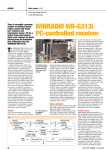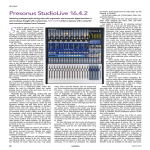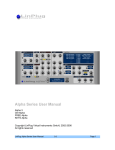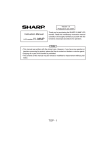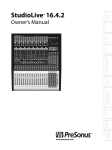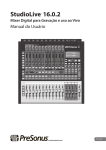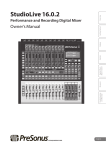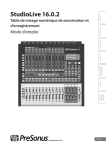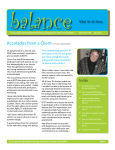Download Presonus Studiolive 16.4.2 Console Issue 72
Transcript
REVIEW Both the stereo main and mono outputs have a mini output level pot. Digital output mirrors the main stereo outputs and is an RCA S/PDIF affair. The only remaining ports are the two Firewire connections. So looking at the I/O, Presonus really hasn’t missed a trick. There’s every form of in and out you’d need for recording and live use, all crammed into the rear of the board. PRESONUS STUDIOLIVE 16.4.2 Presonus brings the studio and the road together in ways not seen before on a small-format console. Text: Brad Watts I have to admit I didn’t see a great future for Presonus earlier this century. The company’s initial audio interface designs were – how shall we say – a little on the clunky side. On a more affirmative note, Presonus’s milled aluminium enclosures of the era looked as if they’d withstand a nuclear tempest. Equally as clunky was the reliance on Yamaha’s mLAN ‘everything-over-a-Firewire-cable’ audio protocol. Not that I’ve anything against mLAN per se; I’m sure the system functions admirably when teamed with Yamaha products. But for a comparatively small company like Presonus looking to push the envelope with its own product range, reliance on yet another third-party’s code was bound to hinder its grand vision. And a grand vision is indeed what Presonus has had in mind for some time. During the last few years there have been a swag of new product releases from the US manufacturer and during that time I’ve become quite a fan of Presonus equipment. The Central Station controller, for example, is a great monitoring device. I’m also quite enamoured of the DigiMax FS and Firestudio units, having recorded with them in various friends’ studios in recent years. These products really have ‘the right stuff ’; features that musicians and recording enthusiasts actually require. The insight behind these designs comes largely courtesy of Jim Odom, the company’s founder, president, and chief strategy officer. And Jim should know a thing or two about recording tools; he’s been an integral member of American Cajun-inspired blues act, LeRoux, since 1982. Jim also currently plays guitar alongside swamp-blues loyalist, Tab Benoit, so he’s no stranger to the real needs of gigging musicians. REAL ESTATE BOOM First up, let’s have a look around the StudioLive. Actually it’s technically known as the StudioLive 16.4.2, for the simple reason that it’s laid out in the familiar configuration of 16 input channels, four mono subgroups, and a two-channel master bus. It’s a pretty standard topology for a small-format console – one that most users should easily come to grips with. When placed flat on a desk, the StudioLive’s faders lie parallel with the ground, while the remaining controls kick up at a slight angle, providing the user with a clear view of all the knobs and switches and placing them within easy reach. The board also comes with a rack-mounting kit should you require it. At this early stage of proceedings I should point out a few of the optional extras available for the StudioLive before I forget. These include a couple of varieties of dust cover, and AT 60 a mounting kit for joining multiple StudioLive consoles together. That’s right, multiple StudioLives can be joined together to create a much larger desk – up to four can be used when the console’s setup as a live board; two when it’s being used as a recording interface. This feature alone should have prospective small console purchasers champing at the bit, as the StudioLive can be expanded to become quite a sizeable live or recording board. A 32-input recording system with dynamics and equalisation DSP on every channel (courtesy of SHARC chips) isn’t a recording platform to be sneezed at. Then, when you consider 64 channels of the same DSPassisted audio paths can be cascaded together for live work for less than 16 grand, suddenly the StudioLive seems destined to become quite a revered ‘little’ desk. As an aside, it’s also possible to augment the input count for recording using other Presonus interfaces such as the Firestudio Tube and Firestudio Project. These are connected via Firewire. ON AIR As a recording platform there’s a lot going on with the StudioLive. To start with there are 16 Presonus XMAX preamps onboard – 17 if you count the talkback mic input. These are a discrete Class-A design that also feature on Presonus’s more recent audio interfaces. The XMAX preamps utilise 30V power rails, and being Class-A they’re always operating at full voltage and ready for business within a nanosecond’s notice. With ample headroom and not an op-amp in sight, these are very honest preamps, capable of accurately amplifying just about anything you throw at them. Each pre features a discrete 48V phantom power button on the top of the console – no global or group phantom switches here – and these glow vividly to let you know they’re on. The exception to this rule is the talkback mic input, the 48V supply of which is always on. Each channel also features a TRS jack line input and an insert point. Direct outputs for each channel are presented on two DB25 D-sub ports. A further set of ‘patchbay’ points include four TRS-balanced Aux inputs – effectively amounting to a pair of stereo returns. Using only the left input will allocate that signal to both the left and right outputs of the board in the case of returning mono equipment. Following these are four balanced, mono subgroups outs, and six balanced auxiliary outputs. Remaining are the main outputs on both XLR and TRS jacks, control room outputs on TRS jacks, a tape I/O on good old RCA connectors, and there’s also a summed mono XLR output. EYES UP Up on the business side of the StudioLive, the story begins with 16 100mm faders for the mono channels, four mono subgroup faders and the master fader. Despite my assumption that these would be motorised, the fact is they’re not. Jim Odom tells me the main focus was on creating a board to assist in front-of-house and live recording, not to reinvent the wheel and create yet another DAW control surface. I was a little disappointed about this at first, but then maybe I’m just a little too used to faders continually jiggling about unattended. And as Jim was keen to point out, motorised faders would have added to the end cost considerably. There is, however, amenity for recall using scene memories. This will save all settings and fader recall with a system similar to the recall on older analogue consoles – move the fader into the correct position and the LEDs assume a ‘nulled’ state. The LED ladders/meters of the ‘Fat Channel’ represent the fader placement according to their positions when a scene is saved to any of the 80 scene locations. When recalling a scene you can decide which categories are recalled. For example, you may want only levels recalled, leaving all EQ and dynamics processing in their current state. SHARC BITE But by now I’m sure you’re keen to hear about the ‘Fat Channel’. This is the interface to the StudioLive’s SHARC DSP-based channel processing, and might I say, it doesn’t do a bad job at all. Arranged horizontally across the console are 16 sets of 16-segment LED meters. While these double as the fader placement guides mentioned previously, their main use is as a visual feedback for parameters of the onboard channel DSP. That processing includes: polarity invert, a high-pass filter, a gate, a fully appointed compressor, and four bands of equalisation. Looking more closely at the compressor we find – apart from the typical threshold, attack (0.2 – 150ms), ratio (1:1 – 14:1), release (40 – 1000ms) and gain controls – backlit buttons for soft-knee attack characteristics, an ‘Auto’ button for automatic attack and release behaviour, and an ‘On’ button to kick in the limiting function. The semi-parametric EQ section is equally well appointed, with each of the four bands featuring defeat buttons, ‘Shelf ’ behaviour for each of the high and low bands, and ‘Hi Q’ buttons for the two remaining midrange bands. The low-mid EQ ranges from 90Hz through to 1.2kHz, with the high-mid EQ ranging from 380Hz through to 5kHz. The low EQ covers 36Hz to 465Hz, and the high-EQ runs from 1.4kHz to 18kHz. So as you see, there’s plenty of overlap between bands if you’re forced to really carve into a signal, along with easy slopes for a bit of general sweetening. All processing is 32-bit floating-point mathematics. Of course, panning gets its own dedicated control with a horizontal 15-segment LED meter, and channels can be linked into stereo pairs as and when required. 16 XMAX mic preamps with individual phantom power switching. Six auxiliary sends should keep most people happy. There's another two feeding the internal effects The nerve centre. Scene memory and recall, along with effect patches. Enough for all your FOH needs. The Fat Channel – displays a wealth of information, not least of which being each channel's DSP settings. Built-in talkback facilities mean there's even less ancilliary gear to buy. 21-fader salute! One for each channel, plus four mono subgroups and a master fader. Remember, these are not motorised. AT 61 AUXILIARIES & BEYOND The StudioLive sports no less than eight auxiliary sends, the first six of which directly feed the six physical aux outputs at the rear of the desk. These are laid out across the top of the board, above the Fat Channel and just below the gain and 48V power section. When you instigate the ‘Mix’ button for an auxiliary, the 16 pots of the Fat Channel section become the aux level controls for each of the 16 desk channels. With auxiliaries two, four, and six, control is available over linked auxiliaries. For example, you could link sends one and two, in which case each pair of Fat Chanel knobs become send level and pan controls respectively. In another feat of foresight and generous DSP allocation, the auxiliary sends can also have Fat Channel processing applied. Nice one Presonus! The two remaining auxiliary sends are strictly mono and these feed the inbuilt effects processors. The effects output can be sent to any of the subgroups, the aux bus, or the main outputs. As for the processing flavours available, Presonus hasn’t gone berserk trying to include every possible effect style. Instead you’ll find 50 variations of reverb and delay – the staples of live sound reproduction. Reverbs include: ambience, halls, various rooms, and a plate reverb, while delays include mono, stereo, the overindulgent ping-pong, and for a touch of analoguestyle slap; a filter delay. “ The StudioLive combines the disparate fields of ‘live’ and ‘studio’ incredibly well, performing admirably in both recording and live situations. KNOCK AT THE DAW ” Of course the StudioLive also functions as an audio interface, and is equally at home in the studio as it is on the road. Connect the desk to your computer via Firewire and you’ve instantly got 16 inputs straight into your DAW. The drivers are compatible with both Apple and Windows operating systems: Windows XP SP2 (32- or 64-bit) or later, or Vista, while on the Apple front, OSX 10.4.11 or OSX 10.5.2 or later. 10.6 is also supported. Obviously you’ll need a Firewire port, which can be a tall order with Apple laptops these days. If you’re intending to run the StudioLive with a Windows machine, be sure to check out the compatibility charts at Presonus’s website for compatible Firewire and graphics card configurations. AT 62 One other specification you should be aware of before jumping into the StudioLive is that the board itself is restricted to sample rates of 44.1 and 48k only. This seems a tad restrictive, although without doubt, running the system at double pace would have placed far greater strain on the available DSP reserves. When used as an interface, the StudioLive offers 16 sends from the desk to your DAW. These are immediate streams from each channel of the StudioLive, and can be quickly set to send the Fat Channel-affected signal to the DAW, or the unadulterated dry signal. A further eight stereo streams are possible from the desk to the DAW, and these can consist of any mixture of paired subgroups, aux sends, either of the two effects processor returns, talkback left and right, two-track left and right, solo left and right, or indeed the main left and right mix. The system is extremely comprehensive, with myriad combinations possible to suit anyone’s recording needs. As suggested earlier, add another StudioLive and you could scarcely be left wanting more. It’s also possible (by virtue of the comprehensive routing) to print tracks back to your DAW using the Fat Channel processing. Merely route the channel back to the DAW via the StudioLive subgroups and you’ve got your EQ and dynamics set in stone. NEED TO KNOW Price $3900 Contact Presonus Australia (02) 9648 5855 [email protected] www.presonus.com.au Pros Effective for both live and recording. Well thought out. Copious bussing and routing options. Easy to operate. Cascadeable. Cons No motorised faders. 48k is the digital limit. Summary Presonus could have a sleeping giant on its hands with the StudioLive. The ‘little desk that could’ will make quite an impact in studios and venues alike. BOTH KINDS Frankly, the StudioLive combines the disparate fields of ‘live’ and ‘studio’ incredibly well, performing admirably in both recording and live situations. As a live console I can see the desk becoming quite the darling for smaller venue installations, or indeed larger venues when two or more StudioLives are daisy-chained together. Being able to syphon off a multitrack recording easily will also make the board attractive to the entrepreneurial venue owner – sets can be recorded oh so easily, and mixed at a later stage. What’s also worth contemplating are the specs of the A/D conversion and the admirable XMAX mic preamps. Presonus has excelled with the StudioLive, providing A/D and D/A conversion with a dynamic range of 118dB (A-weighted) – not bad when you consider that also includes 16 converters for less than four grand. Equally noteworthy are the preamps. Clean, not completely devoid of character, and well appointed in the headroom department. Then when injected into the studio environment, the StudioLive does more than hold its own with an effective talkback system and DSP for miles. From where I stand it’s been the best ‘all rounder’ product of 2009 without doubt. AT 63


